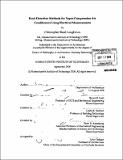| dc.contributor.advisor | Steven B. Leeb, Leslie K. Norford and Peter R. Armstrong. | en_US |
| dc.contributor.author | Laughman, Christopher Reed. | en_US |
| dc.contributor.other | Massachusetts Institute of Technology. Dept. of Architecture. | en_US |
| dc.date.accessioned | 2009-06-30T16:42:23Z | |
| dc.date.available | 2009-06-30T16:42:23Z | |
| dc.date.copyright | 2008 | en_US |
| dc.date.issued | 2008 | en_US |
| dc.identifier.uri | http://hdl.handle.net/1721.1/45938 | |
| dc.description | Includes bibliographical references (p. 409-424). | en_US |
| dc.description | Thesis (Ph. D.)--Massachusetts Institute of Technology, Dept. of Architecture, 2008. | en_US |
| dc.description.abstract | (cont.) This method was experimentally tested and validated on a commercially available air handler and duct system. In the second class of faults studied, liquid refrigerant, rather than vapor, enters the cylinder of a reciprocating compressor during operation. Since the higher cylinder pressures that result can cause substantial damage and are difficult to measure directly, a method for detecting this fault is proposed that only uses observations of the compressor voltage and current. The performance of this fault detection method was also experimentally validated with electrical and mechanical measurements on a semi-hermetic compressor. The final diagnostic method detects refrigerant leakage in a residential air conditioning system by identifying changes in the system's cycling behavior. This method also uses measurements of the compressor's electrical power, as well as a small set of temperature measurements, to determine the presence of the fault. This fault detection method was developed and tested on an occupied residence. | en_US |
| dc.description.abstract | This thesis proposes novel methods that use measurements of electrical terminal variables to identify common mechanical faults in vapor-compression air-conditioners. The importance of air-conditioning in many applications and the current cost of energy both provide powerful incentives for developing fault detection methods, as faults can have a significant impact on the system's functionality and efficiency. While many extant fault detection and diagnostic (FDD) methods depend upon arrays of mechanical sensors, concerns about sensor reliability and the overall complexity of these methods motivated this research into electrically-based FDD methods, which typically incorporate smaller numbers of more reliable sensors. These electrically-based methods use models of the electromechanical energy conversion process to correlate observed changes in the electrical variables to changes caused by faults in the mechanical load. Such an approach allows both electrical and mechanical faults to be identified via the same sensor apparatus, and makes it possible to identify faults that manifest themselves on a wide range of timescales.FDD methods for three different classes of common faults are studied in this research. The first diagnostic method identifies blockage or leakage in a duct via electrical measurements made at the fan motor terminals. The estimates of the motor's speed and torque developed at the operating point are used in tandem with a fan curve to directly estimate the airflow through a duct system without any additional mechanical measurements. | en_US |
| dc.description.statementofresponsibility | by Christopher Reed Laughman. | en_US |
| dc.format.extent | 424 p. | en_US |
| dc.language.iso | eng | en_US |
| dc.publisher | Massachusetts Institute of Technology | en_US |
| dc.rights | M.I.T. theses are protected by
copyright. They may be viewed from this source for any purpose, but
reproduction or distribution in any format is prohibited without written
permission. See provided URL for inquiries about permission. | en_US |
| dc.rights.uri | http://dspace.mit.edu/handle/1721.1/7582 | en_US |
| dc.subject | Architecture. | en_US |
| dc.title | Fault detection methods for vapor-compression air conditioners using electrical measurements | en_US |
| dc.type | Thesis | en_US |
| dc.description.degree | Ph.D. | en_US |
| dc.contributor.department | Massachusetts Institute of Technology. Department of Architecture | |
| dc.identifier.oclc | 320956751 | en_US |
